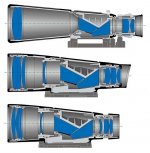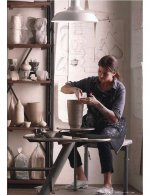Over the last couple of weeks I have been using (in complete awe) a pair of 7x42 Victory FL. Last year I had a pair of 8x32 FL and their performance was good, but they didn’t wow-me away the way the 7x42 do (besides, the ergos of the 8x32 weren't great for me, they just didn't fit my hands).
I am fully aware that between the 8x32 and 7x42 FL's there are many differences such as type of prisms used (SP vs AK), objective diameter, exit pupil diameter, light transmission, FOV and other technicalities that probably escape my understanding, but the thing that really surprised me (besides the brightness) is the three-dimensionality of the image in the 7x42. Ever since I tried a modern porro I’ve been in love with the plasticity and 3D-effect of the image produced by porro binoculars, and I thought that it was impossible to get something closer in roof binoculars. Until now.
A question to those with a deeper technical understanding: is the enhanced 3D effect inherent to Abbe-Köenig prisms? Or does it get augmented in this case by the huge FOV of the 7x42 FL’s and its remarkable light transmission? Are there any other non-porro binocular that might offer such an experience? Are there any SP roofs with a distinctive 3D-effect?
There are things I don’t like about the 7x42 FL, but whenever I look through them the plasticity of the view is such that I just have to pick my jaw from the floor, especially when looking for passerines among the branches, now that they’re frenzy coming and going looking for stuff for their nests.
Out of curiosity, are the 7x42 FL the smallest AK-prism binoculars available? I see that, given that AK prisms are particularly attractive for its light transmission, most of the (small) offer seems to be limited to chunky monsters in the x50/x56 league.
I am fully aware that between the 8x32 and 7x42 FL's there are many differences such as type of prisms used (SP vs AK), objective diameter, exit pupil diameter, light transmission, FOV and other technicalities that probably escape my understanding, but the thing that really surprised me (besides the brightness) is the three-dimensionality of the image in the 7x42. Ever since I tried a modern porro I’ve been in love with the plasticity and 3D-effect of the image produced by porro binoculars, and I thought that it was impossible to get something closer in roof binoculars. Until now.
A question to those with a deeper technical understanding: is the enhanced 3D effect inherent to Abbe-Köenig prisms? Or does it get augmented in this case by the huge FOV of the 7x42 FL’s and its remarkable light transmission? Are there any other non-porro binocular that might offer such an experience? Are there any SP roofs with a distinctive 3D-effect?
There are things I don’t like about the 7x42 FL, but whenever I look through them the plasticity of the view is such that I just have to pick my jaw from the floor, especially when looking for passerines among the branches, now that they’re frenzy coming and going looking for stuff for their nests.
Out of curiosity, are the 7x42 FL the smallest AK-prism binoculars available? I see that, given that AK prisms are particularly attractive for its light transmission, most of the (small) offer seems to be limited to chunky monsters in the x50/x56 league.
Last edited:









